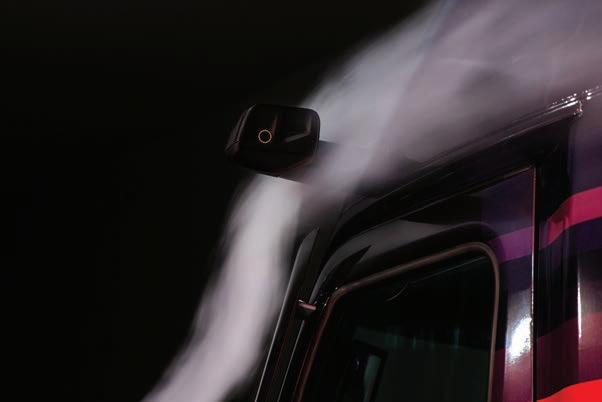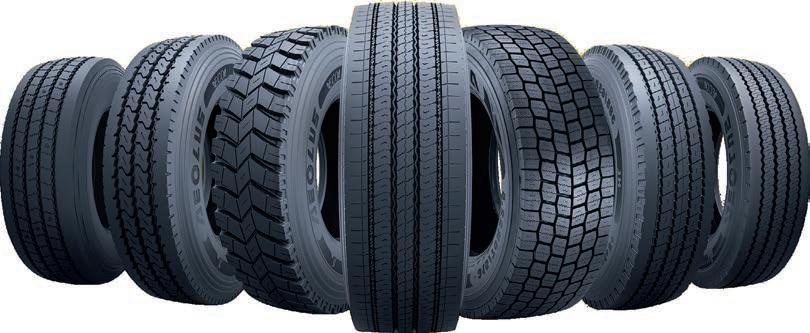
5 minute read
SuperTruck evolves
THERE ARE STILL SIGNIFICANT EFFICIENCY GAINS TO BE squeezed from combustion engines that will further reduce emissions and fuel consumption while improving the performance of heavy-duty trucks.
Daimler Truck North America (DTNA) and its Freightliner brand are shining the spotlight on innovative transport efficiency features with the SuperTruck II design exercise.
As part of the SuperTruck programme co-funded by the US Department of Energy (DOE) with the aim to reduce emissions from on-road freight transportation, DTNA engineers were able to investigate next-generation technologies for heavy-duty commercial trucks and to clear the technical pathway for potential integration into series production.
The prime focus was on developing new technologies on the most promising core components and systems to improve the real world operational efficiency of the truck.
Enhanced tractor aerodynamics, low-rolling resistance tyres, powertrain improvements and energy management with advanced technologies were identified as areas that could potentially enter production for customers in the future.
“Our decision to focus on improvements to core truck components was based on the objective to maximise freight efficiency for our customers while helping to reduce the carbon footprint of trucks and engines,” says Rainer Mueller-Finkeldei, senior vice president of engineering and technology, DTNA.
“Taken all together, the combined innovations developed for the Freightliner SuperTruck II have provided us the opportunity to explore the technologies needed to meet stringent and forthcoming Greenhouse Gas reduction requirements in the coming years.”
Building on the success of SuperTruck I, which overachieved on DOE requirements in 2015, SuperTruck II surpasses expectations in aerodynamics, tyres, powertrain and energy management, while doubling the freight efficiency of the base vehicle from the start of the SuperTruck programme.
Close collaboration between the design and engineering departments delivered the most aerodynamic truck Freightliner has ever built. The teams were able to reduce the aerodynamic drag of SuperTruck II by more than 12% over SuperTruck I.
Instead of radically changing the structure of the truck, the design goal for SuperTruck II was to redefine the existing shape of the current model Cascadia to maximise aerodynamic efficiency and simultaneously employ advanced design language to convey that efficiency.
“We wanted to create a shape that makes efficiency exciting,” said Jeff Cotner, chief designer at DTNA.
“The designers imagined the surfaces of the truck being carved away by the wind. Nature has a way of creating the perfect sculptural shape, when the material is light and airy like snow or sand. This was our inspiration in creating the new expressive form language for the Freightliner brand.
“Sometimes what the eye sees is not what the air sees. We let the area’s most critical to aero performance design themselves and integrated the more expressive lines in the places where the drag is neutral. Our goal was to gain as much freight efficiency as possible and create a beautiful looking truck at the same time. It was important to us that we didn’t change something just for the sake of changing it.”
The redesigned hood, bumper and chassis fairing work with the existing cab structure and now allow the air to flow undisturbed around the truck. The grille, air intakes and doors were redesigned to be as seamless and clean as possible; no sharp edges compromise the aerodynamics or beauty of the truck.
Active side extenders and a roof spoiler system closes the trailer gap by up to 100mm at highway speeds and an enhanced Aerodynamic Height Control lowers the truck for additional aerodynamic improvements.
Thanks to a federal exemption by the National Highway Traffic Safety Administration (NHTSA) for the programme, removing the exterior mirrors and integrating a mirrorless camera system allowed the aerodynamic drag of SuperTruck II to be significantly reduced.
Developed in partnership with Stoneridge, Inc the camera monitoring system has been tested in all weather conditions and shown great promise in enhancing the driver’s visibility and improved vehicle safety. This supports advocacy for future regulatory changes that would permit the widespread adoption of this advanced technology by manufacturers.
SuperTruck II showcases the most efficient powertrain Freightliner has integrated into a truck.
With a non-certified prototype Detroit 13-litre engine featuring two-stage turbo and interstage cooling. With a 13-speed overdrive transmission, the powertrain is able to achieve lower downspeeding and greater fuel savings through reduced drag overdrive, enabling a 5.7% fuel consumption reduction over SuperTruck I.
One key powertrain feature of SuperTruck II is split cooling. This system consists of high-temperature and low temperature cooling circuits, working in tandem with two-stage turbocharging and Exhaust Gas Recirculation (EGR) cooling on the engine. Together, these technologies result in further efficiency gains enabling more aggressive downspeeding.
A smart engine lubrication circuit minimises internal pumping losses and reducing engine parasitics by actively proportioning flow to the most sensitive components.
Adaptive tandem axles are another innovation helping increasing fuel efficiency. It allows increased torque from the fuel-efficient powertrains and automatically shifts from 6x4 to 6x2 at highway speeds while also benefitting the driver when manoeuvring at low speeds.
DTNA again collaborated with SuperTruck I partner Michelin on the development of new tyres specifically designed for the adaptive tandem axles. They not only reduce vehicle energy consumption but also to reduce maintenance downtime due to lower wear on the tires.
In co-development with DTNA, Michelin designed tyres specifically for the steer, drive and tag axles of SuperTruck II. The tyres play a critical role in the efficiency quest and the engineers were able to reduce the tractor rolling resistance by 12% over SuperTruck I. By lowering the friction on the road, less fuel is needed to maintain the truck speed.
The introduction of dynamic load shift further increases efficiency and fuel savings. With this technology, some of the load will be shifted automatically from the drive axle to the tag axle to take advantage of the tag tyre low rolling resistance. The design of the new tyres included development of new treads and compounds that translated into more than 20% improvements in drive tyre wear and tear and overall significantly improved rolling resistance.
SuperTruck II also features an innovative 48-volt electrical system with lithium-ion batteries, enabling a new electric steering system to adjust demand as needed, whether the operator is manoeuvring at low speed or driving at highway speeds, or to operate during EcoSail while the engine is off.
The intelligent EcoSail feature can turn the engine off when drive power is not needed, without requiring any intervention from the driver. At the same time, if the truck is coasting down a hill while the engine is off, features like air conditioning remain in operation. As soon as power is needed, the engine will restart automatically for a seamless experience for the driver.
Other 48-volt features include a new electric air conditioning system that consumes 50% less energy than SuperTruck I and continues seamless operations while the engine is turned off.

A new 48-volt starter turns on the engine with more power and speed. Finally, the new 48-volt electrical system operates the hoteling features without the engine running while delivering 12-volt power for the standard cab items like lighting or the instrument cluster.
The thermal management for the 48V battery was developed in partnership with the National Renewable Energy Laboratory. Other partners include Oak Ridge National Lab (combustion and core engine research), University of Michigan (predictive engine controls) and Clemson University (thermal barrier coating development).
A number of innovative features from DTNA’s first SuperTruck are available today in the Freightliner Cascadia, including enhanced aerodynamics, improved engine thermal efficiency and powertrain integration technologies such as downspeeding, and predictive powertrain controls.
DTNA has also been awarded a grant for SuperTruck III to develop a hydrogen fuel cell electric tractor that exceeds heavy-duty long-haul sleeper performance, efficiency, and range requirements without compromising payload. SuperTruck III designs are planned to be revealed by 2027. T&D










